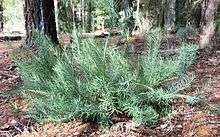Podocarpus drouynianus
| Podocarpus drouynianus | |
|---|---|
 | |
| Scientific classification | |
| Kingdom: | Plantae |
| Division: | Pinophyta |
| Class: | Pinopsida |
| Order: | Pinales |
| Family: | Podocarpaceae |
| Genus: | Podocarpus |
| Species: | P. drouynianus |
| Binomial name | |
| Podocarpus drouynianus | |
Podocarpus drouynianus is a species of podocarp native to the relatively high rainfall southwestern corner of Western Australia, where it is known by the name emu berry,[1] wild plum[2] or native plum although it is not a true plum. The Noongar name for the plant is koolah.[3]
Description
The plant is usually a shrub, not often forming a single trunk, instead growing multiple branches from around the base. It looks like a conifer, typically grows to a height of 0.75 to 3 metres (2 to 10 ft)[2] and forms clumps a few metres wide.[1] It is dioecious[2] and very slow-growing. The bark is thin and fibrous, green in colour turning red-brown on the outside. The leaves are needle-like, 4 to 8 centimetres (1.6 to 3.1 in) long, sharply pointed, green above and with glaucous stomatal bands beneath. The cones are berry-like, with a fleshy, edible purple aril 2 to 2.5 cm (0.79 to 0.98 in) long and one (rarely two) apical seeds 1 cm (0.39 in)1 cm long.
Distribution
It grows on lower slopes and low-lying areas and around creeks in the South West and Great Southern regions of Western Australia where it grows in loamy, sandy or gravelly soils.[2] It is associated as part of the understorey species present in lowland jarrah and karri and it spreads mostly by root suckering.[1] The extent of occurrence of the species is less than 20,000 square kilometres (7,722 sq mi) over multiple locations. The total area of occupancy by P. drouynianus has reduced as a result of clearing of forest for pasture and the replacement of native forest with exotics.[4]
Cultivation
Ideally Podocarpus drouynianus should be grown in partial shade with plenty of water. Unusually for the genus, it tolerates quite dry conditions. It survives temperatures of up to 45 °C, and grows well in full sun or partial shade.
Classification
The species was initially described by the botanist Ferdinand von Mueller in 1864 in his work Fragmenta Phytographiae Australiae. There are two synonyms for this species: Nageia drouyniana and Podocarpus drouyniana.[5] The species name honors the statesman Edouard Drouyn de Lhuys who was a member of the Institut de France.[1]
References
| Wikimedia Commons has media related to Podocarpus drouynianus. |
- Conifer Specialist Group (2008). "Podocarpus drouynianus". IUCN Red List of Threatened Species. Version 2008. International Union for Conservation of Nature. Retrieved 27 March 2009. Database entry includes justification for why this species is listed as data deficient
- 1 2 3 4 "Podocarpus drouynianus F. Muell. 1864". The Gymnosperm Database. 23 November 2013. Retrieved 13 December 2016.
- 1 2 3 4 "Podocarpus drouynianus". FloraBase. Western Australian Government Department of Parks and Wildlife.
- ↑ "Noongar names for plants". kippleonline.net. Archived from the original on 20 November 2016. Retrieved 13 December 2016.
- ↑ Thomas, P. & Farjon, A. (2013). "Podocarpus drouynianus". The IUCN Red List of Threatened Species. IUCN. 2013: e.T34066A2842380. doi:10.2305/IUCN.UK.2013-1.RLTS.T34066A2842380.en. Retrieved 23 December 2017.
- ↑ "Podocarpus drouynianus F.Muell". Atlas of Living Australia. Global Biodiversity Information Facility. Retrieved 12 December 2016.
